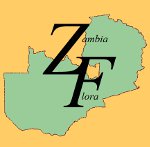Information about the species data pages
The information for a particular species consists of the following. At this stage, some items may be missing or incomplete. Where we have little information about a species, we display a message in red text in a box asking for further content.
- Scientific name plus authority
The authority is abbreviated in accordance with the standard published in Brummitt & Powell (1992).
- Selected images
A row of images from Zimbabwe is shown. These are a selection of better quality images illustrating features of the particular species. Where we have no images from Zimbabwe, images taken in other countries are displayed. All the images we have for this species in the sites' database, whether they are from Zimbabwe or any other countries and whether they are of good quality or not, can be displayed by clicking on the 'View all images' link.
- Links to species records and various mapping pages
Beneath the images is a row of links. The first link is to the records for the particular species. The maps display records on a Quarter Degree Square basis and as individual points.
- Synonyms
Included under this term are not only true synonyms but misapplied names and spelling variants.
- Common names, i.e. popular English (and/or vernacular) names.
In the English names, we have followed a general pattern of capitalising the first word but not the second, e.g. Velvet bushwillow. In a few, rare, cases, we have done something different if the result so produced is ridiculous for some reason.
Vernacular names are shown in English, Shangaan, Ndebele, Ndau, Shona and Tonga (Zimbabwe).
- Frequency
A subjective impression, using the following simple scale: common, frequent, occasional, local, rare.
- Status
Not a standardised field. Describes whether the taxon is native, introduced and/or cultivated.
- Description
In drawing up the descriptions of families and genera, these have often been widened to take account of species outside the flora area. However, where all the species in the flora area have a specific character, this has often been noted in the descriptions by the phrase "(in our species)" or simply "(in ours)", thus reducing the space taken up by irrelevant information.
In the descriptions, reference to an unqualified measurement is to the length of an object. A reference to (for example) 4-5 × 1-2 cm, means the length is 4-5 cm and the width is 1-2 cm. Measurements enclosed in brackets (for example: leaves 7-10(-15) cm) are exceptional cases outside the normal range; however, even these measurements may not be the absolute extremes.
The length of the species descriptions is variable and is generally longer in the larger families and genera. The species descriptions usually exclude characters already mentioned under the genus; both must be read. Important features have been placed in italics for emphasis.
- Type location
The location at which the type specimen of the species was collected.
- Notes
This is a slot for miscellaneous information about the species which is not dealt with elsewhere.
- Derivation of specific name
An explanation, where known, of the scientific species name is given.
- Habitat
A non-standardised field describing the habitat in which the taxon occurs.
- Altitude range
This is given as a range in metres. Note that at present, many of the altitude ranges are incomplete or provisional and further information may well extend these considerably.
- Flowering time
The monthly range of flowering times. Extremes are indicated in brackets.
- Worldwide distribution
For each family, genus and species, the total worldwide number of genera and/or species is given, together with a brief summary of the worldwide distribution. This information has been extracted from various sources, often either from FZ or from Mabberley (1997).
- Botanical distribution
For Botswana, Malawi, Mozambique, Zambia and Zimbabwe, this is the distribution used in Flora Zambesiaca. For DRC, the distribution is that of Flore d'Afrique Centrale. There are no divisions for Burundi, Caprivi and Rwanda.
- Zambian distribution (Provinces). This is a provincial distribution used as an alternative to the distribution used in Flora Zambesiaca.

- Growth form: the following classification is used. The meanings are the same as those on the spot-characters page.
Growth form Spot id and link to page Annual 16 Aquatic 6 Biennial 17 Climber 1 Epiphyte 13 Liane 18 Lithophyte 14 Perennial 19 Shrub over 2 m 20 Shrub under 2 m 21 Tree 2 Terrestrial (used in Orchidaceae and ferns only) 22 - Endemic status
See the endemic species page for full details.
- Red Data status code
See the red data page for full details.
- Insects
Information about species of insects which are associated with particular plant species is sometimes available and we have created pages giving basic information, with images, about each insect species, with links to and from the species of plant.
- Spot characters
See the spot characters page for full details.
- Images last updated
Used when images are first added or major additions are made. The date shown here appears on the website home page as well and provides a link to recent content.
- Literature
This comprises a list of literature relevant to this particular species. Literature about the family and/or genus is not necessarily repeated here but may be found by viewing the family and genus pages.
